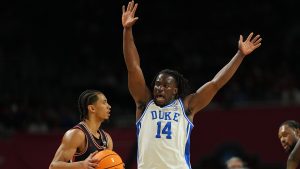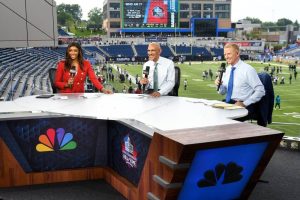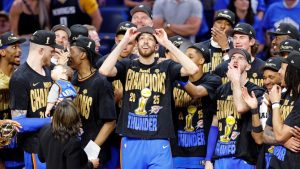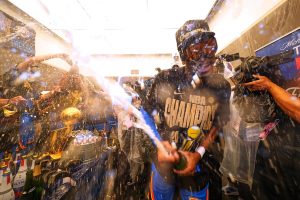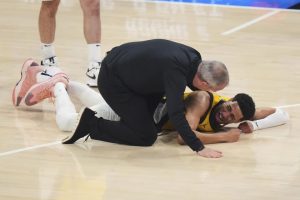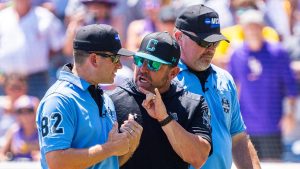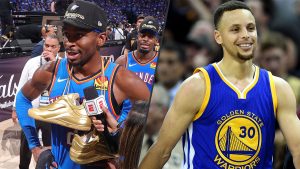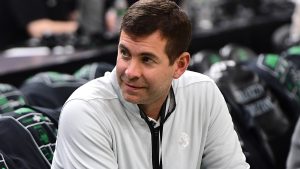
These were supposed to be the boring finals, a contest between two small-city teams with none of the media pull of Boston or New York or even Denver for that matter, featuring the (allegedly) most overrated guard in the NBA, no personalities, relentless fouling, and a Canadian MVP whose ascendancy seemed to indicate nothing more than the terminal decline of America as a stable of elite basketballing talent. Instead we were treated to the most thrilling and unpredictable finals since LeBron James came through with his famous rejection in 2016 – a bustling, punishing, seven-game exhibition of physical basketball whose outcome was genuinely unclear until the final quarter of the season. Denigrated and dismissed by a basketballing commentariat who’ve spent much of this season ruing the modern NBA’s dearth of charisma, Oklahoma City and Indiana played as if stung by the laugh lines, launching from both ends of the court with a kind of mad, symphonic intensity.
If the finals of the past few years were about punctuating a dynasty (Golden State in 2022), letting Nikola Jokić be Nikola Jokić (Denver in 2023), and mastering a technocratic synthesis of all the elements of the modern game (the Celtics last season), this was a victory built on turnovers, flops, dives, steals, slingshot passes, and snap threes from distance. It was grubby at times, but it was all the more beautiful for its lunging desperation. At the end of it all, the team with the best regular-season record and the best player in the league emerged victorious. In years to come this stat line alone may confer a sheen of inevitability over the season. But Oklahoma City’s victory in Sunday night’s decider – like these finals and the playoffs generally – was anything but predictable. Even after star guard Tyrese Haliburton, who played through the finals with a calf strain, exited the court with a ripped achilles late in the first quarter, the Pacers would not give up.
Related: The $10bn LA Lakers sale proves sports have outgrown even most billionaires
By the time the triumphant Thunder players made it to the trophy podium, they seemed so drained by their accomplishment they didn’t know how to behave. With an average age of 25.6, these are the youngest NBA champions in almost half a century – and at the moment of climax it’s fair to say their inexperience finally showed. “It’s your time guys, celebrate,” presenter Lisa Salter encouraged them as the TV formalities concluded. Draped in confetti, SGA, J Dub and the rest proceeded to do nothing, milling around the Larry O’Brien trophy like interns at their first summer networking event awkwardly circling the buffet. Never has a champion NBA team so comprehensively rebuked its cultural critics on the court while confirming the basic accuracy of their critique off it.
With their love of group interviews, relentless positivity, and unfortunate penchant for barking, this vintage of the Oklahoma City Thunder often seems more like an a cappella troupe than a basketball team, a band of barber shop Harlem Globetrotters ready to pop up on the campus of our collective psyche at any moment and begin a relentless assault of harmonization and good vibes. Head coach Mark Daigneault is fond of describing them as an “uncommon” team – but what may be most uncommon about them is how supremely, relatably dorky they are. In a world of professional trolls, red-pilled everything and constant worry about the state of Young Men Today, there’s something vaguely refreshing about a group of perky young dudes who carry themselves with the amiable, well mannered aspect of a wealth management professional talking you through reallocation options for your 401k. It also helps, of course, that they are very good at basketball – and these finals have offered a stunning, all-court demonstration of their versatility across the boards.
Shai Gilgeous-Alexander is, of course, the supernova, a player so richly accomplished – and syllabic – that at the underripe age of 26, he’s already earned the right, like MJ, CP3 and KD before him, to be known by his initials. SGA put together 15 30-point performances throughout this playoff run, a total exceeded during a single postseason by only Michael Jordan in 1992 and Hakeem Olajuwon in 1995. After Sunday night’s game, he is also the first player in 25 years to scoop all three of the regular season MVP award, the finals MVP gong, and the season scoring title. Not since Shaquille O’Neal was getting around the court in shorts big enough to dress a king bed has there been a player as dominant across all the major awards categories over a single season.
SGA’s rise is all the more improbable when you consider his relative softness from three point range, which is – or so the last decade would have us think – the route to glory in today’s NBA. Where other greats of the modern game dominate through power, speed, or precision, SGA’s great skill is variation: variation of pace in the paint, variation of the shooting angles he creates for himself, variation of the heights from which he detonates his lethal mid-range game. He’s as comfortable unleashing one inch off the floor as he is stepping back to gain elevation over an isolated marker, and with the ankle elasticity of prime Gaël Monfils his joints allow him to turn even the most improbable looks into routine buckets. The freakish and frankly slightly scary vision of Gilgeous-Alexander’s calves operating at 45 degrees to his feet has become a constant of these finals; at other times he’s shown his uncommon comfort with a game played at waist height, tucked in on himself, headband showing like a set of antlers, fending forward with a hyper-extended leg then snapping back to reel off another unsplashily effective jumper.
This is a player so rich in mobility, so relentlessly and inventively productive, that it’s almost boring to catalogue his routes to the basket. One incredible sequence during a critical stretch of the fourth quarter in Game 5, right as the Pacers were threatening another madcap comeback, saw Gilgeous-Alexander steal the ball off a wayward Andrew Nembhard pass, vacuum up the court, assess two defenders, launch himself short of them, hang for what seemed like five seconds, then extend his left arm forward like a human selfie stick to sink the bucket of the glass, drawing a foul in the process. Poison at one end and caviar at the other: this is the Shai Gilgeous-Alexander guarantee, the recipe that allows him to cook so ferociously every time he steps on the court.
Each member of the Thunder supporting cast brings their own presents to the party: Chet Holmgren, the “unicorn” big that the Thunder nabbed with the second overall draft pick in 2022, offers a windmilling protection under the rim far more robust than his rope-like physique might suggest; Jalen Williams, at 24, has shown signs that he could match or even one day exceed SGA’s prodigious offensive stats; Alex Caruso plays the old hand (he’s 31, but that’s positively ancient by the standards of this team), calming the kids or jamming the opposition’s spokes as the occasion demands; Lu Dort, a four-fingered Florentine steak of a man, has the name of a 1980s action movie villain and the brawn to match. For all the individuality of these weapons, however, this is very much a team built in SGA’s image, all stretching and running. Relentless movement, positional interchanges, defense wielded as an offensive weapon, offense that flows seamlessly into defense, limbs that bend like liquid … Had I not already gone for an aquatic metaphor, it would be tempting to describe this as a cappella basketball – but even then the imagery doesn’t quite work, because the Thunder operate at a different level, exploding the rigidity of fixed harmonic divisions. No one in this team ever holds the same line; basses, tenors, and counter-tenors all merge, sharing each other’s music. When one Gilgeous is put down, an Alexander pops up; you might get past Jalen Williams, but then you have to deal with Jaylin Williams.
Thirteen years ago the Thunder made it to the finals with their magical trio of Kevin Durant, Russell Westbrook, and James Harden. The rebuild since that near-champion team broke up has been long, and at various points – especially three years ago, when Oklahoma City finished the regular season with just 24 wins – it looked like it might all come to nothing. Now the reward for general manager Sam Presti’s patience is a young team of champions who stand a good chance of finally breaking the post-Warriors NBA’s cycle of parity. This Thunder roster looks likely to stay intact for the next few seasons – and who, legitimately, will stand in their way of a second ring? The Celtics’ hopes of another title to complement last year’s depend on Jayson Tatum’s achilles; the Jokić-led Nuggets look a few players short of a champion roster; Ant’s Timberwolves aren’t ready; the Lakers have prime Luka but an aging LeBron, plus a looming change of ownership to contend with. Perhaps the Thunder’s stiffest challengers next year will be the ones they’ve just faced.
A word, then, for the fallen. In their strutlessness, commitment, and lack of ego, this Indiana team resemble nothing so much as their vanquisher last night. As they put together their historic run to the finals – the franchise’s first in 25 years – they took on the air of a team of destiny, an ensemble for whom no deficit was too great and no amount of time to reverse it too small. For a brief moment last night, as 6ft 1in point guard TJ McConnell, asked to step up in place of the injured Haliburton, repeatedly blew past Holmgren, a man one foot his superior, and conjured a string of evading layups high off the glass, it seemed like the masters of the comeback were about to pull off their greatest heist yet. Instead the Thunder gradually reasserted control, Holmgren rediscovered the gift of his wing span, and as the final quarter began the fans at Paycom Center got the celebrations under way.
In years to come the defining image of the night – and of this season – may not be of Gilgeous-Alexander accepting the finals MVP award with a rueful grin, or of Caruso pumping the home crowd when victory was all but assured. Instead it will be of a stricken Haliburton thumping the court in distress toward the end of the first quarter as he understood that his achilles, like his participation in the title decider, was done. The exit of the Pacers star, who started these playoffs saddled with the tag of the NBA’s most overrated player and ends them widely hailed as arguably the most clutch player that basketball has seen since Kobe Bryant, robbed the spectacle of some of its tension, however valiant the Tyrese-eless Pacers’ resistance remained in the face of looming defeat. But their miraculous run to the finals will not be forgotten soon: the Thunder may have had the most complete season, but no team in this year’s NBA has produced better quarters than Indiana. Haliburton will be back, maybe even before the end of next season – and the Pacers will be restless to complete the last step of the journey begun with last season’s eastern conference finals appearance and this year’s advance to the big dance.
Polite, young, considerate, and barkingly competitive on the court, these two teams seem set to define professional basketball for the next decade. The NBA has officially entered its nice guy era – and if it goes on to produce more postseasons as absorbing as this year’s, all the grumbles about the league’s lack of personalities and swagger, all the agita about the end of basketballing cool and American MVPs and Anthony Edwards being the sport’s only hope will, one imagines, fairly quickly fade into history.
These were supposed to be the boring finals, a contest between two small-city teams with none of the media pull of Boston or New York or even Denver for that matter, featuring the (allegedly) most overrated guard in the NBA, no personalities, relentless fouling, and a Canadian MVP whose ascendancy seemed to indicate nothing more than the terminal decline of America as a stable of elite basketballing talent. Instead we were treated to the most thrilling and unpredictable finals since LeBron James came through with his famous rejection in 2016 – a bustling, punishing, seven-game exhibition of physical basketball whose outcome was genuinely unclear until the final quarter of the season. Denigrated and dismissed by a basketballing commentariat who’ve spent much of this season ruing the modern NBA’s dearth of charisma, Oklahoma City and Indiana played as if stung by the laugh lines, launching from both ends of the court with a kind of mad, symphonic intensity.
If the finals of the past few years were about punctuating a dynasty (Golden State in 2022), letting Nikola Jokić be Nikola Jokić (Denver in 2023), and mastering a technocratic synthesis of all the elements of the modern game (the Celtics last season), this was a victory built on turnovers, flops, dives, steals, slingshot passes, and snap threes from distance. It was grubby at times, but it was all the more beautiful for its lunging desperation. At the end of it all, the team with the best regular-season record and the best player in the league emerged victorious. In years to come this stat line alone may confer a sheen of inevitability over the season. But Oklahoma City’s victory in Sunday night’s decider – like these finals and the playoffs generally – was anything but predictable. Even after star guard Tyrese Haliburton, who played through the finals with a calf strain, exited the court with a ripped achilles late in the first quarter, the Pacers would not give up.
Advertisement
Advertisement
Advertisement
Related: The $10bn LA Lakers sale proves sports have outgrown even most billionaires
By the time the triumphant Thunder players made it to the trophy podium, they seemed so drained by their accomplishment they didn’t know how to behave. With an average age of 25.6, these are the youngest NBA champions in almost half a century – and at the moment of climax it’s fair to say their inexperience finally showed. “It’s your time guys, celebrate,” presenter Lisa Salter encouraged them as the TV formalities concluded. Draped in confetti, SGA, J Dub and the rest proceeded to do nothing, milling around the Larry O’Brien trophy like interns at their first summer networking event awkwardly circling the buffet. Never has a champion NBA team so comprehensively rebuked its cultural critics on the court while confirming the basic accuracy of their critique off it.
With their love of group interviews, relentless positivity, and unfortunate penchant for barking, this vintage of the Oklahoma City Thunder often seems more like an a cappella troupe than a basketball team, a band of barber shop Harlem Globetrotters ready to pop up on the campus of our collective psyche at any moment and begin a relentless assault of harmonization and good vibes. Head coach Mark Daigneault is fond of describing them as an “uncommon” team – but what may be most uncommon about them is how supremely, relatably dorky they are. In a world of professional trolls, red-pilled everything and constant worry about the state of Young Men Today, there’s something vaguely refreshing about a group of perky young dudes who carry themselves with the amiable, well mannered aspect of a wealth management professional talking you through reallocation options for your 401k. It also helps, of course, that they are very good at basketball – and these finals have offered a stunning, all-court demonstration of their versatility across the boards.
Shai Gilgeous-Alexander is, of course, the supernova, a player so richly accomplished – and syllabic – that at the underripe age of 26, he’s already earned the right, like MJ, CP3 and KD before him, to be known by his initials. SGA put together 15 30-point performances throughout this playoff run, a total exceeded during a single postseason by only Michael Jordan in 1992 and Hakeem Olajuwon in 1995. After Sunday night’s game, he is also the first player in 25 years to scoop all three of the regular season MVP award, the finals MVP gong, and the season scoring title. Not since Shaquille O’Neal was getting around the court in shorts big enough to dress a king bed has there been a player as dominant across all the major awards categories over a single season.
Advertisement
Advertisement
Advertisement
SGA’s rise is all the more improbable when you consider his relative softness from three point range, which is – or so the last decade would have us think – the route to glory in today’s NBA. Where other greats of the modern game dominate through power, speed, or precision, SGA’s great skill is variation: variation of pace in the paint, variation of the shooting angles he creates for himself, variation of the heights from which he detonates his lethal mid-range game. He’s as comfortable unleashing one inch off the floor as he is stepping back to gain elevation over an isolated marker, and with the ankle elasticity of prime Gaël Monfils his joints allow him to turn even the most improbable looks into routine buckets. The freakish and frankly slightly scary vision of Gilgeous-Alexander’s calves operating at 45 degrees to his feet has become a constant of these finals; at other times he’s shown his uncommon comfort with a game played at waist height, tucked in on himself, headband showing like a set of antlers, fending forward with a hyper-extended leg then snapping back to reel off another unsplashily effective jumper.
This is a player so rich in mobility, so relentlessly and inventively productive, that it’s almost boring to catalogue his routes to the basket. One incredible sequence during a critical stretch of the fourth quarter in Game 5, right as the Pacers were threatening another madcap comeback, saw Gilgeous-Alexander steal the ball off a wayward Andrew Nembhard pass, vacuum up the court, assess two defenders, launch himself short of them, hang for what seemed like five seconds, then extend his left arm forward like a human selfie stick to sink the bucket of the glass, drawing a foul in the process. Poison at one end and caviar at the other: this is the Shai Gilgeous-Alexander guarantee, the recipe that allows him to cook so ferociously every time he steps on the court.
Each member of the Thunder supporting cast brings their own presents to the party: Chet Holmgren, the “unicorn” big that the Thunder nabbed with the second overall draft pick in 2022, offers a windmilling protection under the rim far more robust than his rope-like physique might suggest; Jalen Williams, at 24, has shown signs that he could match or even one day exceed SGA’s prodigious offensive stats; Alex Caruso plays the old hand (he’s 31, but that’s positively ancient by the standards of this team), calming the kids or jamming the opposition’s spokes as the occasion demands; Lu Dort, a four-fingered Florentine steak of a man, has the name of a 1980s action movie villain and the brawn to match. For all the individuality of these weapons, however, this is very much a team built in SGA’s image, all stretching and running. Relentless movement, positional interchanges, defense wielded as an offensive weapon, offense that flows seamlessly into defense, limbs that bend like liquid … Had I not already gone for an aquatic metaphor, it would be tempting to describe this as a cappella basketball – but even then the imagery doesn’t quite work, because the Thunder operate at a different level, exploding the rigidity of fixed harmonic divisions. No one in this team ever holds the same line; basses, tenors, and counter-tenors all merge, sharing each other’s music. When one Gilgeous is put down, an Alexander pops up; you might get past Jalen Williams, but then you have to deal with Jaylin Williams.
Thirteen years ago the Thunder made it to the finals with their magical trio of Kevin Durant, Russell Westbrook, and James Harden. The rebuild since that near-champion team broke up has been long, and at various points – especially three years ago, when Oklahoma City finished the regular season with just 24 wins – it looked like it might all come to nothing. Now the reward for general manager Sam Presti’s patience is a young team of champions who stand a good chance of finally breaking the post-Warriors NBA’s cycle of parity. This Thunder roster looks likely to stay intact for the next few seasons – and who, legitimately, will stand in their way of a second ring? The Celtics’ hopes of another title to complement last year’s depend on Jayson Tatum’s achilles; the Jokić-led Nuggets look a few players short of a champion roster; Ant’s Timberwolves aren’t ready; the Lakers have prime Luka but an aging LeBron, plus a looming change of ownership to contend with. Perhaps the Thunder’s stiffest challengers next year will be the ones they’ve just faced.
Advertisement
Advertisement
Advertisement
A word, then, for the fallen. In their strutlessness, commitment, and lack of ego, this Indiana team resemble nothing so much as their vanquisher last night. As they put together their historic run to the finals – the franchise’s first in 25 years – they took on the air of a team of destiny, an ensemble for whom no deficit was too great and no amount of time to reverse it too small. For a brief moment last night, as 6ft 1in point guard TJ McConnell, asked to step up in place of the injured Haliburton, repeatedly blew past Holmgren, a man one foot his superior, and conjured a string of evading layups high off the glass, it seemed like the masters of the comeback were about to pull off their greatest heist yet. Instead the Thunder gradually reasserted control, Holmgren rediscovered the gift of his wing span, and as the final quarter began the fans at Paycom Center got the celebrations under way.
In years to come the defining image of the night – and of this season – may not be of Gilgeous-Alexander accepting the finals MVP award with a rueful grin, or of Caruso pumping the home crowd when victory was all but assured. Instead it will be of a stricken Haliburton thumping the court in distress toward the end of the first quarter as he understood that his achilles, like his participation in the title decider, was done. The exit of the Pacers star, who started these playoffs saddled with the tag of the NBA’s most overrated player and ends them widely hailed as arguably the most clutch player that basketball has seen since Kobe Bryant, robbed the spectacle of some of its tension, however valiant the Tyrese-eless Pacers’ resistance remained in the face of looming defeat. But their miraculous run to the finals will not be forgotten soon: the Thunder may have had the most complete season, but no team in this year’s NBA has produced better quarters than Indiana. Haliburton will be back, maybe even before the end of next season – and the Pacers will be restless to complete the last step of the journey begun with last season’s eastern conference finals appearance and this year’s advance to the big dance.
Polite, young, considerate, and barkingly competitive on the court, these two teams seem set to define professional basketball for the next decade. The NBA has officially entered its nice guy era – and if it goes on to produce more postseasons as absorbing as this year’s, all the grumbles about the league’s lack of personalities and swagger, all the agita about the end of basketballing cool and American MVPs and Anthony Edwards being the sport’s only hope will, one imagines, fairly quickly fade into history.


